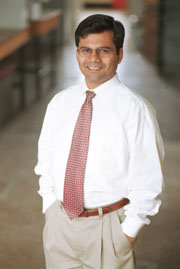
| ||
 | ||
 Professor Subhasis Ghoshal PHOTO: OWEN EGAN |
Cleaning up
|
SYLVAIN COMEAU | Every year, environmental clean-up crews at the site of oil spills face a daunting, nearly impossible task. Subhasis Ghoshal wants to improve their odds. Working with graduate students, Ghoshal, a professor in the Department of Civil Engineering and Applied Mechanics, is working on groundbreaking projects which may contribute to the next generation of environmental remediation technologies. In one ongoing project, Ghoshal is studying the effects of petroleum oils.
"Over time, crude oil, when immersed in water, forms rigid skins. This was already known, but we discovered that these skins actually prevent leaching of toxic contaminants from the coal tar into water. They act almost like a garbage bag. "This is important because the big problem with spills is not the oil itself, but the toxins that are slowly released into the soil, the groundwater or the sea." Ghoshal notes that coal tars also form similar skins. "This means that contamination from a tar or oil spill actually decreases with time. We didn't know that before; it's a big deal, because we can now reevaluate the long-term risks to the environment. "An obvious application would be to replicate the process in the case of gasoline and diesel, which don't form these kinds of skins at all. That's a more practical solution than trying to clean up the entire spill, which is often impossible." Why? Because bioremediation, one of the best methodsstill has its limits. "Bioremediation means using bacteria which break down contaminants into harmless forms, like carbon dioxide and water. The problem is that the bacteria commonly used for that purpose usually cannot survive in a site contaminated by heavy metals, like chromium and arsenic. Clean-up crews don't even attempt bioremediation under these conditions." However, in the lab, Ghoshal and his team "trained" bacteria to become more resilient. "For the first time, we have shown that bacteria can handle both jobs at once; they can break down both organic compounds like naphthalene, and turn heavy metals like chromium into non-toxic forms. The difference is that we exposed the bacteria to heavy metals, conditioning them to survive in that environment." So clean-up crews may soon be able to send special lab-trained bacteria to attack a wider variety of sites. The need for such breakthroughs is urgent because site owners often simply cannot live up to stringent environmental regulations, even if they devote years and millions of dollars to the problem. "Often, clean-up crews will spend years cleaning up a site and find that no matter what they do, they still can't meet required regulations. That can be very frustrating." Ghoshal is working on developing scientific criteria and standardized tests by which clean-up crews can prioritize their work. "The reality is that any site owner and clean-up crew has limited resources, which they sometimes spend on unrealistic tasks. If there is a rigorous scientific basis for saying that a contaminant won't move anywhere else, and the land won't be used as a children's playground or for growing crops, it might not be necessary to clean everything in order to live up to regulations. Currently, that scientific basis doesn't exist. That might also be a rationale for changing regulations to make them more realistic. "As we say in our field, that would tell us how clean is clean." Ghoshal's research is funded by the Natural Sciences and Engineering Research Council of Canada, Petro-Canada and the Fonds FCAR. He is the winner of the 1998 McGill University Petro-Canada Young Innovator Award.
|
|
| |||||